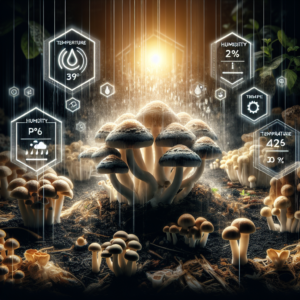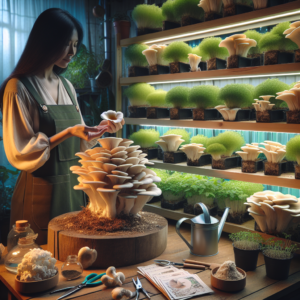
When it comes to mushroom cultivation, precision is key. The difference between a mediocre batch and a bumper crop often lies in the details of your climate control. Let’s dive into how to master temperature and humidity to achieve mushroom perfection.
Key Takeaways
- Optimal temperature and humidity are crucial for successful mushroom cultivation.
- Signs of suboptimal conditions include slow growth, abnormal cap development, and vulnerability to pests.
- Temperature control systems range from simple thermostats to advanced programmable units.
- Humidity can be regulated using misting systems, humidifiers, or automated solutions.
- Regular monitoring and adjustments ensure a consistent environment for mushroom growth.
Creating the Ideal Environment for Mushrooms
Understanding the specific needs of your mushroom variety is the first step to creating an environment where they can thrive. Most mushrooms prefer a cool and moist environment, but the exact parameters can vary. For instance, while oyster mushrooms flourish at 55-60°F, shiitakes may prefer slightly warmer conditions.
Why Temperature and Humidity Matter
Mushrooms are sensitive to their surroundings, particularly to temperature and humidity. These factors influence everything from the speed of mycelial growth to the final size and quality of the fruiting bodies. Temperature affects the metabolic rate of the fungi, while humidity impacts the moisture content crucial for their development.
Signs Your Mushroom Climate Isn’t Optimal
If you notice your mushrooms are growing slowly, have thin or brittle caps, or there’s a sudden infestation of pests, these could be tell-tale signs that your growing conditions need adjustment. Here’s what to watch for:
- Slow Growth: Indicates that temperatures may be too low or too high.
- Abnormal Cap Development: Swollen or cracked caps can suggest humidity issues.
- Pests: A climate that’s too dry can attract pests like spider mites.
Mastering Temperature: Setting the Stage for Growth
Now, let’s get your temperature dialed in. The goal is to keep the growing area within a range that promotes vigorous mycelium colonization and fruiting. Achieving this steady state is easier with the right equipment.
Choosing the Right Temperature Control System
When selecting a temperature control system, consider the following options:
- Basic Thermostats: For small setups, a simple thermostat can suffice, turning heating or cooling devices on and off to maintain the set temperature.
- Programmable Controllers: More advanced systems allow you to set different temperatures for various stages of mushroom growth.
Maintaining Consistent Temperatures in Your Grow Space
Once you have your system in place, monitor the temperature regularly. Sudden fluctuations can stress your mushrooms, leading to lower yields. Use fans to distribute heat evenly and avoid hot or cold spots in your growing area.
Here’s an example of a simple setup:
A small grow tent with a thermostat-controlled heater for the winter months and a fan to cool down during summer. The thermostat is set to maintain a steady 60°F, ideal for growing oyster mushrooms.
Remember, consistency is your best friend when growing mushrooms. With the right temperature control system in place, you’re setting the stage for success.
Monitoring and Adjusting Humidity for Peak Mushroom Health
Humidity is just as crucial as temperature in the world of mushroom cultivation. It’s the water vapor in the air that mushrooms use to grow, and without enough of it, they can’t develop properly. Keep a hygrometer handy to check humidity levels regularly, aiming for that sweet spot of 90-95% for most varieties during the fruiting phase.
Combining Systems: Integrated Climate Control Solutions
For those serious about mushroom cultivation, integrated climate control systems are the way to go. These systems manage both temperature and humidity, ensuring they work in harmony. This coordination is vital because changes in temperature can directly affect humidity levels and vice versa.
Using a combined system reduces the risk of human error and takes much of the guesswork out of the equation. It means you’re less likely to have to deal with the consequences of an environment that’s too dry or too damp for your mushrooms to thrive.
Benefits of Using Combined Temperature and Humidity Controllers
Here’s why integrated controllers are a game-changer:
- They streamline the growing process, making it easier to manage.
- You can set it and forget it, allowing the system to make the necessary adjustments automatically.
- It’s an investment that pays off with higher yields and better quality mushrooms.
Implementing Automation for Consistency and Efficiency
Automation is the secret ingredient for a hassle-free cultivation experience. Automated climate control systems can adjust the temperature and humidity based on the time of day or the growth stage of the mushrooms. This way, your mushrooms get exactly what they need, when they need it, without you having to lift a finger.
For example, you might use a system that:
Automatically increases humidity during the night when temperatures drop, ensuring that the mushrooms stay hydrated without becoming waterlogged.
Automation not only saves time but also reduces the risk of human error, making your mushroom cultivation process more reliable and less labor-intensive.
Selecting Your Control Systems: Factors to Consider
Now, before you rush out to buy the first climate control system you find, let’s consider what you really need. The size of your grow space, the variety of mushrooms you’re cultivating, and your budget all play a role in deciding which system is right for you.
Understanding the Needs of Different Mushroom Varieties
Different mushrooms have different needs. For instance, the button mushroom might prefer cooler and more stable conditions, while tropical varieties might thrive in a warmer and more humid environment. Do your research to understand the specific requirements of your chosen mushroom variety.
Incorporating Cost-effective Climate Control Strategies
Climate control doesn’t have to break the bank. Here are a few cost-effective strategies:
- Start with a small, simple setup and scale up as you gain experience and confidence.
- Use timers and thermostats to control equipment only when necessary, reducing energy consumption.
- Insulate your grow space to maintain temperatures more easily and reduce the need for heating or cooling.
Practical Tips for Mushroom Growers
Here are some hands-on tips to help you get the most out of your mushroom cultivation:
Keep your grow area clean to prevent the introduction of contaminants that can affect temperature and humidity. A clean space is a stable space.
Be attentive to the changing seasons. What works in the summer might not be suitable for the winter months. Adjust your climate control settings accordingly.
Simple Adjustments for Big Impact
Sometimes, it’s the little things that make the biggest difference. For example, moving your grow setup away from windows can prevent temperature swings caused by sunlight. Similarly, adding a small fan can improve air circulation and prevent pockets of stagnant air that can lead to mold growth.
Common Pitfalls to Avoid in Climate Management
Even the most diligent mushroom growers can make mistakes. Here are some common pitfalls to avoid:
- Over-adjusting: Making too many changes too quickly can stress your mushrooms. Small, incremental adjustments are best.
- Ignoring signs of distress: If your mushrooms aren’t looking happy, don’t just hope for the best. Take action to correct the environment.
- Forgetting to calibrate: Equipment like thermostats and hygrometers can drift over time. Regular calibration ensures accuracy.
Advancing Your Growth: The Future of Climate Control in Mushroom Cultivation
As technology advances, so too do the opportunities for precision in mushroom cultivation. Smart systems that can be controlled via smartphone apps are already on the market, and the future promises even more sophisticated solutions.
Investing in these technologies not only makes your job easier but can also lead to more sustainable production practices. By optimizing energy use and reducing waste, these systems are not just good for your mushrooms—they’re good for the planet.
Whether you’re a hobbyist or a commercial grower, understanding and implementing effective temperature and humidity control systems is key to your success. By paying attention to the details and utilizing the right tools, you can achieve mushroom perfection in your grow operation.
Common Pitfalls to Avoid in Climate Management
Even the most diligent mushroom growers can make mistakes. Here are some common pitfalls to avoid:
- Over-adjusting: Making too many changes too quickly can stress your mushrooms. Small, incremental adjustments are best.
- Ignoring signs of distress: If your mushrooms aren’t looking happy, don’t just hope for the best. Take action to correct the environment.
- Forgetting to calibrate: Equipment like thermostats and hygrometers can drift over time. Regular calibration ensures accuracy.
Advancing Your Growth: The Future of Climate Control in Mushroom Cultivation
As technology advances, so too do the opportunities for precision in mushroom cultivation. Smart systems that can be controlled via smartphone apps are already on the market, and the future promises even more sophisticated solutions.
Innovations on the Horizon
Imagine climate control systems equipped with artificial intelligence that learns from your mushrooms’ growth patterns and makes real-time adjustments. Such innovations are not far off, and they’re set to revolutionize the way we grow mushrooms.
Investing in Technology for Sustainable Production
Investing in these technologies not only makes your job easier but can also lead to more sustainable production practices. By optimizing energy use and reducing waste, these systems are not just good for your mushrooms—they’re good for the planet.
Frequently Asked Questions (FAQ)
What is the Ideal Temperature Range for Growing Mushrooms?
The ideal temperature range for growing mushrooms varies depending on the species, but most varieties thrive between 55°F and 75°F. Some, like the oyster mushroom, prefer the cooler end of the spectrum, while others, such as the button mushroom, may tolerate slightly warmer conditions.
How Often Should Humidity Levels Be Checked in a Mushroom Growing Area?
Humidity levels should be checked at least once a day, but more frequent checks may be necessary if you’re in a particularly dry or fluctuating environment. Keeping a close eye on humidity helps prevent the substrate from drying out and ensures the mushrooms have the moisture they need to grow.
Can You Use Regular Household Humidifiers for Mushroom Cultivation?
While regular household humidifiers can be used for small-scale mushroom cultivation, they may not provide the precise control or capacity needed for larger operations. Specialized humidifiers designed for mushroom growing are usually a better choice for maintaining consistent and high humidity levels.
What Are the Signs of Too Much Humidity in Mushroom Growth?
Too much humidity can lead to waterlogged substrates, overly wet mushrooms, and the potential for mold and bacterial growth. Signs include slimy or discolored mushrooms, a musty smell, and the presence of mold on the substrate or fruiting bodies.
How Can Climate Control Systems Impact Mushroom Yield and Quality?
Proper climate control systems can significantly impact both the yield and quality of mushrooms. By providing a stable environment, these systems help ensure that mushrooms grow to their full potential, both in size and in nutritional content. They also help in preventing common issues like mold and dryness, which can ruin entire batches.


